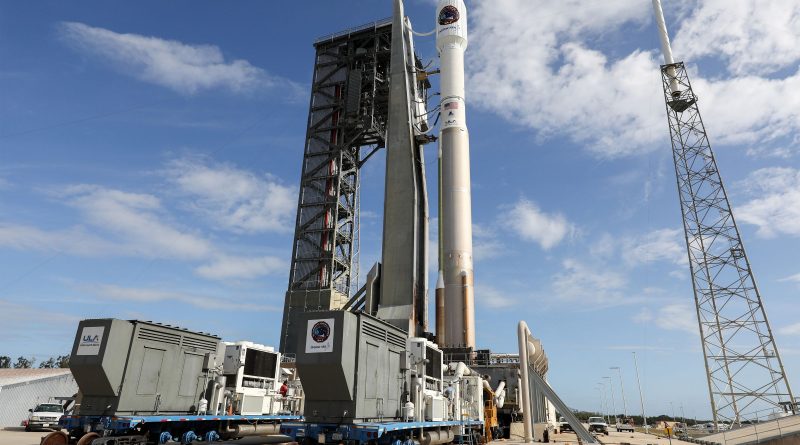Atlas V stands ready to Launch Cygnus OA-7 on Science Cargo Delivery to ISS
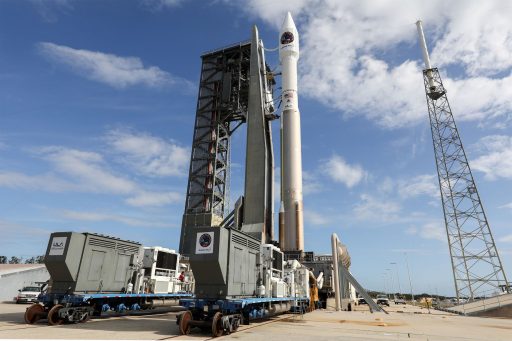
An Atlas V rocket is standing tall atop its launch pad at Florida’s Space Coast in preparation for liftoff on Tuesday with Orbital ATK’s Cygnus cargo ship, ferrying more science hardware to the International Space Station than any U.S. Commercial Cargo vehicle to date.
The cargo ship, named the S.S. John Glenn in honor of the late Mercury 7 astronaut, has a half-hour launch window opening at 15:11 UTC, 11:11 a.m. local time at Cape Canaveral Air Force Station. Climbing away from Florida, Atlas V will be in action for 20 minutes to lift Cygnus into a 230-Kilometer orbit from where the spacecraft will maneuver to an altitude of 400 Kilometers to catch up with the Space Station on Saturday.
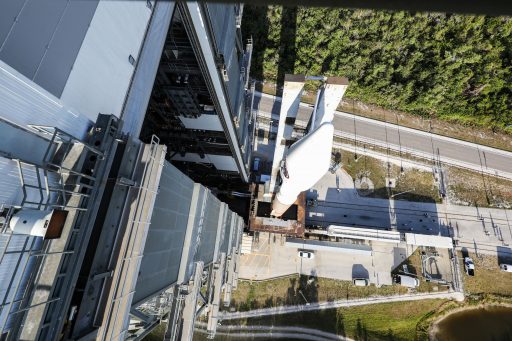
The 58-meter tall Atlas V emerged from its assembly facility at 8:20 a.m. local time on Monday, completing a half hour trip over to its launch pad at Space Launch Complex 41 to be centered in its precise liftoff position for a final day of launch preparations. Tuesday’s liftoff will come after a month-long delay to the mission caused by hydraulic issues on the ground and the first stage of the rocket, requiring extensive work to clean up spilled hydraulic fluid, replace a ruptured line on the Common Core Booster and work through a detailed anomaly investigation.
Cygnus remained in position atop the stacked rocket throughout the lengthy delay, hidden from view inside Atlas V’s extra-extended four-meter payload fairing, offering plenty of room for the enhanced Cygnus version that is making its fourth flight, sporting a larger cargo compartment to take on more supplies headed to ISS. Managers convened on Saturday for the Launch Readiness Review, going over steps taken to recover from the hydraulic issues and looking at the overall readiness for the mission. With no red flags, the way was clear for rollout and launch.
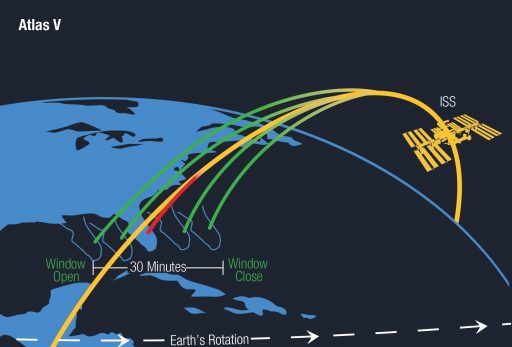
Tuesday’s half-hour launch window is the result of Atlas V’s unique steering capability that allows the rocket to maneuver back into the orbital plane of the Space Station if liftoff occurs out-of-plane. Other launchers like SpaceX’s Falcon 9, the Russian Soyuz, and Orbital’s Antares only have brief windows of a few seconds to a few minutes which typically end up being instantaneous opportunities – allowing only one shot of launching per day.
Atlas V’s window spans from 15 minutes before to 15 minutes after the exact moment the Earth’s rotation carries the Station’s orbital plane over Cape Canaveral. This allows flexibility for the Atlas V to wait out unfavorable weather conditions or provide time to deal with technical issues – maximizing the odds of getting the vehicle off the ground on the first try. Tuesday’s window includes five discrete launch opportunities – each with its own guidance solution for Atlas V to find its orbital destination. These opportunities are spaced every seven and a half minutes starting with the opening second of the launch window at 15:11:23 UTC.
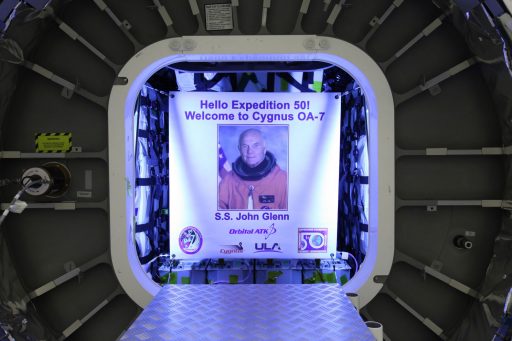
Meteorologists are optimistic about Tuesday’s launch slot, issuing 90% odds of favorable weather conditions during the half-hour window. Cape Canaveral is currently under the influence of a high pressure area with low moisture content and only slight chances of an isolated shower or two. Meteorologists are expecting a high deck of scattered Cirrostratus clouds topping out at 30,000 feet and a lower deck of scattered cumulus clouds between 3,000 and 7,000 feet, the latter of which is the only concern for liftoff. Winds will be around 10 to 12 kts from the sea and temperatures will be hovering around 24°C.
Tuesday’s launch will mark the 71st Atlas V launch and the 653rd launch of a vehicle named Atlas, coming 55 years after John Glenn departed Florida on top of Mercury-Atlas 6 to become the first American to orbit the Earth. The Cygnus S.S. John Glenn will enjoy a ride on a much evolved version of the Atlas rocket, marking the third flight of the Orbital ATK spacecraft on the ULA workhorse rocket after a successful mission in 2015 and a close-shave with launch failure in March 2016.
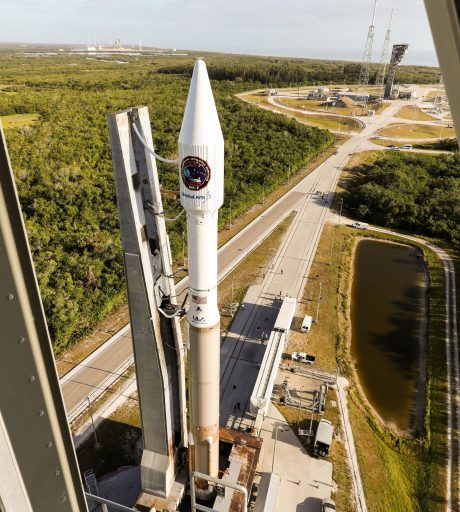
A novelty of Tuesday’s launch will be the first live 360-degree broadcast of a rocket launch to be carried on NASA’s YouTube channel via a camera placed around 90 meters from the launch pad. The camera unit comprises four individual cameras and a computer processor stitches the four individual feeds to provide a full 360 view of the launch pad with users able to select the sector they want to view.
United Launch Alliance provided 360° videos of previous Delta IV missions, but not as part of their live mission coverage. One technical challenge for the live 360° broadcast was patching the audio into the feed which requires the countdown net audio feed to be routed to the camera at the launch pad. The system was tested during last month’s Delta IV launch with WGS9 and the stream will go live around ten minutes prior to Tuesday’s liftoff.
Cygnus OA-7 has been switched from a planned launch atop Orbital ATK’s Antares to use the more powerful Atlas V to take up an additional 300kg of supplies and count on Atlas V’s schedule certainty to get to the Station ahead of a busy summer of science experiments with 216 studies planned during Expedition 51/52 aboard the U.S. Segment alone.
Weighing in at 7,229 Kilograms, Cygnus is loaded with 3,459 Kilograms of cargo comprised of 954kg of crew supplies, 1,215kg of systems hardware and most notable 940kg of science and utilization hardware – more than any previous commercial resupply mission carried to ISS.
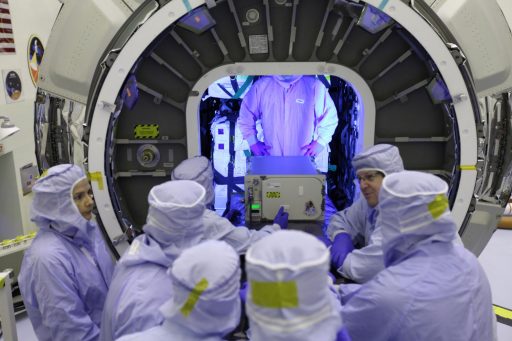
Cargo loaded into the Italian-built Pressurized Cargo Carrier ranges from mundane items such as food provisions and toilet paper to sophisticated facilities like NASA’s Advanced Plant Habitat that will take up residence on the Station to provide critical information for the space farmers of tomorrow that will rely on plants to recycle carbon dioxide and provide food for extended journeys through the cosmos. Utilization hardware on the OA-7 mission also includes the third SAFFIRE experiment that studies how fires spread in a spacecraft, four Polar freezers loaded with microbiology experiments, and a total of 38 CubeSats to be deployed from the Space Station and the Cygnus craft itself.
Cygnus is carrying 92 bags filled with food, personal items for crew members scheduled to arrive later this year, replaceable parts for the Station’s space suits and EVA tools, various components needed to maintain the Station’s internal systems and critical items required for a May 12 spacewalk that will restore data connectivity to an external payload platform and assess the cooling system of the Station’s prime astrophysics payload, the Alpha-Magnetic Spectrometer 2.
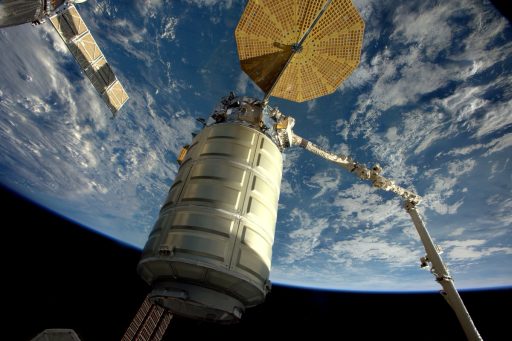
Cygnus will take the scenic route to the Space Station, gradually raising its orbit over four days to stay out of the way on Thursday when Russia’s Soyuz MS-04 spacecraft will take off from the Baikonur Cosmodrome and travel to ISS on the express lane to deliver Expedition 51/52 crew members Fyodor Yurchikhin and Jack Fischer. On Saturday, Cygnus will use its GPS and laser guidance systems to fly up to ISS from a position directly below – coming to a halt within reach of the Station’s robotic arm.
At the controls of the robotic arm will be Thomas Pesquet, ESA Astronaut of French nationality, while veteran NASA Astronaut Peggy Whitson backs up Pesquet by handling communications with the ground and commanding of the Cygnus spacecraft. Following a planned 10:05 UTC capture, ROBO controllers on the ground will take over to bring Cygnus into position on the Earth-facing port of the Unity module where the spacecraft will be bolted into place for an 80-day stay.
Atlas V Countdown & Launch Sequence
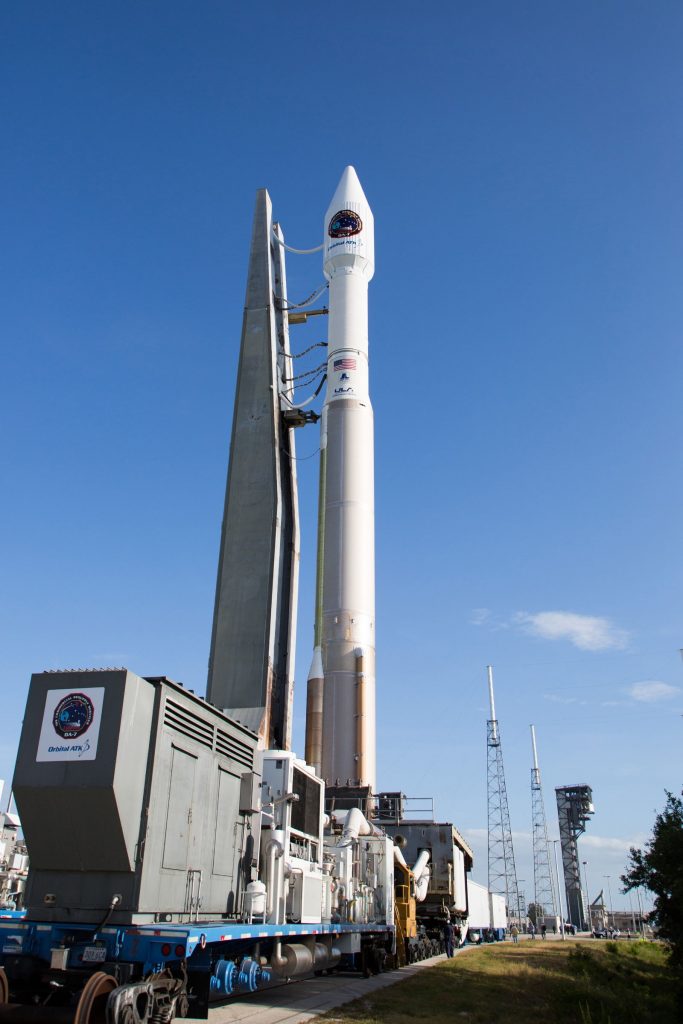
Atlas V enters its lengthy countdown operation seven hours prior to the day’s T-0 target with the activation of the two-stage rocket to then undergo a multi-hour checkout operation to ensure all subsystems are ready to support the mission. At the pad, the first hours of the countdown are dedicated to final physical reconfigurations to button up the launch vehicle and ground facility before engineers depart the complex to enable hazardous operations to commence.
Approaching L-4 hours, the Launch Team puts the Atlas V through a series of communication checks on its S- and C-Band Systems and also goes through Flight Termination System testing before applying the purge flow to the vehicle in advance of propellant loading.
At T-2 Hours, the countdown enters a built-in hold during which teams perform the fueling pre-task briefing and the GO/No GO Poll for propellant loading.
As soon as the countdown resumes at T-2 hours, propellant loading operations start. The complex procedure to load the two stages of the rocket with cryogenics begins with the chilldown of ground support equipment and transfer lines and tanks chilldown on the Liquid Oxygen side.
Liquid Oxygen starts flowing into the Centaur upper stage tanks shortly thereafter, starting a 40-minute sequence to load the tanks with around 15,700 liters of –183-degree Celsius oxidizer.
Once Centaur is into propellant loading, the large Liquid Oxygen tank of the Common Core Booster also starts fueling. LOX load on the CCB also moves through the three steps, slow-fill, fast-fill and topping to deliver around 185,000 liters of LOX to its tank. The Common Core Booster is loaded with 94,600 liters of Rocket Propellant 1 (refined Kerosene) on Monday, ahead of the launch countdown.
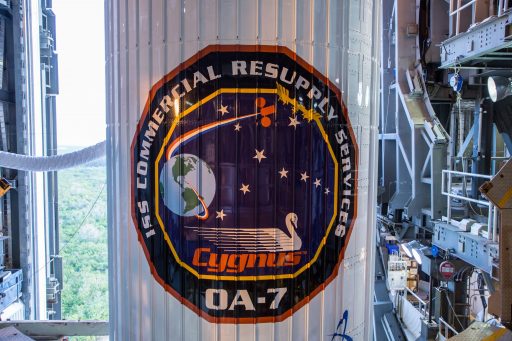
The final tank to be loaded during the countdown is the Liquid Hydrogen Tank of the upper stage that also goes through the usual steps to be filled with 48,100 liters of -253-degree Celsius LH2 fuel. Centaur can look back at over 200 previous missions – most of which coupled with an Atlas – a duo that has been operating for several decades.
When clocks reach T-4 Minutes, the countdown enters its second built-in hold for final polling of the launch team prior to pressing into Terminal Count. This hold can be extended in case of technical issues or uncooperative weather.
As clocks start ticking down from T-4 Minutes, final vehicle configurations such as ordnance arming, flight termination system arming, propellant tank pressurization, transfer to internal power, and flight control system reconfigurations will be made as part of the Automated Sequence to place the vehicle in its launch configuration.
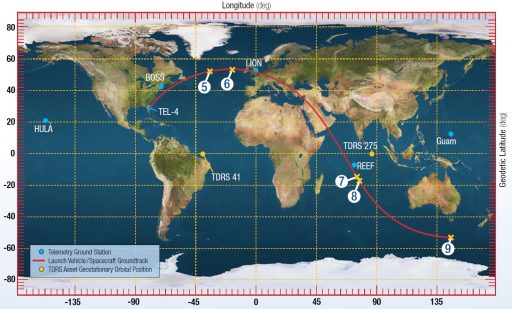
At T-2.7 seconds, the massive two-chamber RD-180 main engine of the Common Core Booster ignites and soars up to its full liftoff thrust of 390,250 Kilogram-force. Engine start-up is closely monitored by flight computers to make sure it reaches operational conditions before the launcher is committed to flight.
Without any Solid Rocket Boosters, the Atlas V 401 makes a relatively slow initial ascent with a Thrust to Weight Ratio of 1.16 – gimbaling the two engine nozzles to remain in an upright position.
After ascending vertically for 18 seconds, the Atlas V will begin its pitch and roll maneuver to align itself with its pre-determined flight path, departing Florida’s Space Coast to the north-east on a coast-hugging trajectory ahead of crossing the Atlantic ocean.
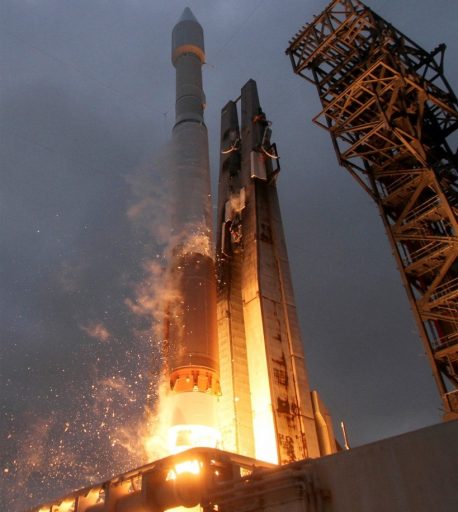
Atlas V will push through the sound barrier 73 seconds into the flight followed by the point of Maximum Dynamic Pressure eleven seconds later. Burning 1,150kg of propellants per second, the first stage will continue firing on all cylinders while the Centaur upper stage begins readying for ignition by pressurizing its Hydrazine tanks and chilling down its main engine.
Reaching T+4 minutes, Atlas V will start throttling back the RD-180 to maintain a maximum acceleration of 5Gs.
Four minutes and 16 seconds into the flight, the first stage will shut down its RD-180 engine after consuming 284 metric tons of propellant. At T+4:22, six seconds after shutdown, pyrotechnics will be fired to separate the Common Core Booster that then uses eight small solid rocket motors to move away from the Centaur upper stage.
At T+4:32, the RL-10C engine of the Centaur Upper Stage will ignite on its first and only burn of this mission – soaring to 11,200 Kilogram-force of thrust to push Cygnus into orbit via a firing of 13 minutes and 50 seconds. Seven seconds into the burn, Centaur will jettison its protective payload fairing to shed no-longer-needed weight and reveal Cygnus for the rest of its trip into orbit.
Cygnus is aiming for a circular orbit of 230 Kilometers at an inclination of 51.6 degrees for spacecraft separation 21 minutes and one second after launch to begin its mission. Immediately after separation, Cygnus begins stabilizing its orientation and contacts mission control through NASA’s Tracking and Data Relay Satellites. Solar Array deployment – the last milestone for Tuesday’s launch is planned after one lap around the planet.
For Centaur, the mission will continue with an 11-second long retrograde deorbit burn 48 minutes and 30 seconds after liftoff to drop the spent rocket stage out of orbit with impact of any surviving parts 69 minutes after launch, south of Tasmania.

